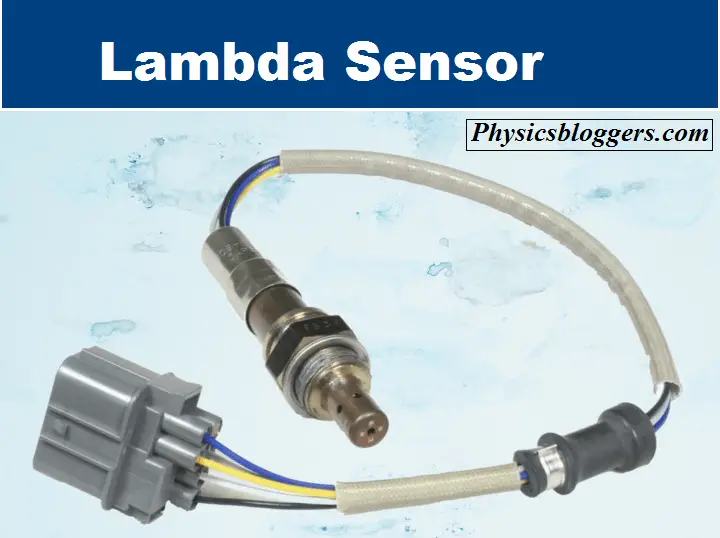Lambda sensor || Oxygen sensor || Applications of Lambda sensor

Lambda sensor
An electric device known as an oxygen sensor is also known as a lambda sensor. These two names both denote the same object. It can determine how much oxygen is present in the exhaust gases produced by current automobiles. It is an extremely important factor in ensuring that the engine operates correctly and that the catalytic converter does its job effectively. As shown below

The lambda sensor is installed inside the exhaust pipe within the exhaust system. After measuring the amount of oxygen present in the exhaust gases, the engine control unit (ECU) receives feedback from this component. Based on this information, the ECU makes the necessary adjustments to the air-fuel mixture introduced into the engine.
Types
There are two major types of lambda sensors used in vehicles:
I) Zirconia sensor II) Titania sensor
Zirconia sensor
This sensor is the most common. The Zirconia sensor consists of a ceramic element coated with zirconium dioxide. It generates a voltage signal that varies depending on the oxygen content in the exhaust gases.
Titania sensor
The Titania sensor, on the other hand, uses a titanium dioxide coating and measures the oxygen content based on changes in electrical resistance.
Working
The working of the lambda sensor is:
Sensor Construction
As mentioned earlier, this sensor is made up of zirconium dioxide (ZrO2) or titanium dioxide (TiO2), and The ceramic element is coated with a porous layer of platinum on both sides. A metal casing protects the electrical connections.
Electrochemical Reaction:
The lambda sensor operates based on an electrochemical reaction that takes place within the ceramic element. The ceramic material acts as an electrolyte and allows oxygen ions (O2-) to migrate through it.
Sensor Heating:
This sensor needs to reach a certain temperature to operate effectively. Most lambda sensors have an integrated heating element that helps raise the temperature quickly. The vehicle’s electrical system or an external heater usually powers the heating element.
Oxygen Partial Pressure:
The oxygen ion exchange occurs across the ceramic element when there is a difference in the oxygen partial pressure between the reference chamber and the exhaust gases.
Voltage Output:
The lambda sensor starts operating at the temperature of around 300-600°C and generates output voltage. The sensor measures the difference in oxygen concentrations between the exhaust gases and the ambient air.
Voltage Generation:
The ion exchange generates a voltage potential across the platinum electrodes on either side of the ceramic element. The voltage output depends on the difference in oxygen concentrations and is typically in the range of 0.1V to 0.9V.
Differential Oxygen Concentration:
There is a reference chamber in this sensor to expose the ambient air, which serves as a baseline for comparison. The exhaust gases pass over the other side of the sensor and have a varying oxygen concentration depending on the air-fuel mixture.
Challenges
i) Heavy fuel usage.
ii) Substantial exhaust emissions.
iii) Engine performance issues.
iv) Error codes are recorded.
v) An engine indicator lamp illuminates.
Applications
Respiration of Soil
Oxygen sensors may be used in collaboration with carbon dioxide sensors to assist in characterizing soil respiration. Soil oxygen sensors typically use a galvanic cell to generate a current flow proportionate to the oxygen concentration being measured.
Automotive Emissions Control:
To track the amount of oxygen in exhaust gases, automobiles often utilize lambda sensors. This information is transmitted back to the engine control unit (ECU), which modifies the air-fuel ratio in real time to keep it as near to the stoichiometric ratio as feasible.
Performance and Fuel economy:
Lambda sensors help to maximize engine performance and fuel economy. The engine functions in its most effective condition, consuming less fuel and producing more power, when the optimum air-fuel ratio is maintained.
Monitoring of Industrial Emissions:
Lambda sensors are employed in a variety of industrial applications, including keeping an eye on the emissions from boilers, internal combustion engines, and other combustion processes. Industries may reduce their environmental effect and follow emission rules by managing the air-fuel ratio.
On-Board Diagnostics (OBD):
Lambda sensors are crucial parts of onboard diagnostics (OBD) systems in automobiles. They support the monitoring of the operation of the catalytic converters and emission control system, enabling the identification and reporting of any problems or malfunctions.
Recent developments
Some recent developments in this sensor are:
Wideband Lambda Sensors:
Air-fuel ratio (AFR) sensors, sometimes referred to as wideband lambda sensors, are increasingly common in contemporary automobiles. Wideband sensors give more accurate and continuous monitoring of the air-fuel ratio than conventional narrowband sensors, which only produce a binary rich/lean signal. With the use of this technology, fuel injection systems may be controlled better, and emissions can be monitored more precisely.
Faster Response Times:
It’s possible that manufacturers have improved lambda sensors’ response times. In dynamic driving situations, quicker reaction times enable the engine control unit to alter the air-fuel mixture more quickly, improving engine performance and reducing emissions.
Durability and Longevity:
Enhancing the lifetime and endurance of lambda sensors may be the focus of recent advances. Increasing the life of these sensors would save maintenance costs and improve the overall dependability of the vehicle.
Integrated Sensor Solutions:
Lambda sensors may be combined with other sensors and systems in the vehicle to provide the engine control unit access to more thorough data. More advanced engine management techniques that further optimize combustion processes may result from this connection.



